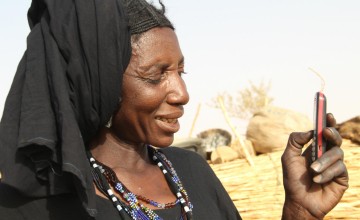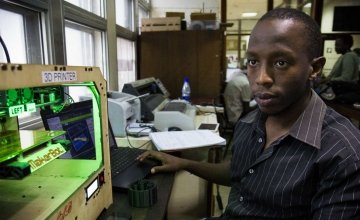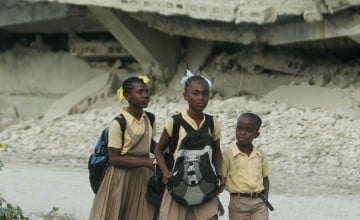
Read our 2024 annual report

Knowledge Hub
How can new technology impact humanitarian action?

From flying donkeys to Facebook, there are countless ways that emerging technologies are changing the face of development in the world’s poorest countries.
Here, we take a look at some of the innovations that Concern and other humanitarian organisations are beginning to work with.
Ebola relief and the internet
In an age when everywhere from beaches to graveyards have their own public WiFi networks, broadband internet is a service that we take for granted. For countries fighting the Ebola outbreak, however, connectivity has been a precious commodity.
For health workers racing to save lives and limit contagion, every minute can make a difference. An hour spent sending an email or a day waiting on a status update is time wasted. Managing supplies and basic humanitarian logistics placed an enormous strain on the communications infrastructure of Sierra Leone and Liberia. Our ability to map outbreaks and respond effectively was hampered.
Enter Facebook.
In 2013 CEO Mark Zuckerberg founded Internet.org, an initiative aimed at making internet access available to the two-thirds of the world population that does not yet have it.

As part of Facebook’s response to Ebola, the social networking giant provided NetHope with broadband connections via its existing satellite network.
NetHope is a consortium of corporations and humanitarian organisations like Concern that specialises in improving connectivity in areas affected by disaster. This collaboration has been essential in our response to emergencies in the past, including during the 2010 Haiti earthquake and Typhoon Haiyan responses.
Engaging Internet.org’s satellites provided free broadband access to medical facilities in Liberia, Sierra Leone and Guinea. This allowed our aid workers in remote areas contact to patients and powered their ability to coordinate easily with each other.
It is expected that the legacy of this emergency action will result in much increased connectivity in those countries hit by Ebola. This kind of advance in communications, it is hoped, would help the countries react in a far quicker and more impactful way in the case of future emergencies.
Digital wallets and mobile banking

In 2015, mobile cash exchange has yet to go truly mainstream. Tech corporations all want a slice of the business, as seen in the battle between products like Google Wallet and Apple Pay. But Concern has been using mobile cash transfers for almost ten years. What’s more: it’s a system that works on the most basic of mobile phones.
The Doha emergency cash transfers programme was rolled out in Malawi in 2006. In partnership with a bank, this service allowed us to reach isolated rural communities with no access to formal banking services. Since then, the programme’s success has led to a wider adoption of mobile cash transfer programmes across the humanitarian sector.
Over time, we have developed cash transfer systems in line with new technology.
From Nairobi’s slums to drought-stricken Niger, mobile cash transfers have had a profound impact both in crisis and on long-term development. In some areas, the cash transfer system has even had a positive effect on gender imbalance. By offering women more financial responsibility in their households, there is an opportunity for their empowerment on a domestic and community level.
It is predicted that mobile phone use is set to increase twenty-fold in Africa in the next five years (that’s twice the rate of growth across the rest of the world), which will only serve to increase how effective these evolving cash transfer systems will be on the continent.
Digital data gathering

In the light of WikiLeaks, the global financial crisis and the Edward Snowden revelations, ‘Big Data’ has picked up a big share of bad press. Evolving data-gathering technology, however, is also having a positive impact in global development issues.
The IDSUE (Indicator Development for Surveillance of Urban Emergencies) project is one good example.
Concern is creating a tool that both governments and the wider humanitarian community can use to provide real-time support in urban slums. IDSUE is a system of data collection and monitoring that has been developed in Nairobi, Kenya, to pre-empt crisis for the most vulnerable people in the city.
Whether escalating gang violence, water shortages or disease outbreaks, there is a whole network of shocks that can lead to disaster for those living in slums.
Because of the complexity and inequality of big cities like Nairobi, it has been difficult to grasp a true picture of the vulnerability of the poor.
The IDSUE system makes the invisible visible, and allows NGOs and government bodies to react in a much swifter manner for disaster risk reduction. As a majority of the global population now lives in urban areas, these kinds of data-gathering systems will become more and more essential to protecting the poor.
Three more emerging technologies

3D Printing
Since its arrival as a consumer product in recent years, 3D printers have rapidly become popular for a plethora of different applications.
From fabricating agricultural tools to manufacturing medical equipment on a small scale, the 3D printing industry has a revolutionary potential for the alleviation of poverty.
Drones
Just as alluring for anybody with a passing interest in tech has been the rise of commercially-available drones.
The BBC and Wired have described how “flying donkeys” (drones that carry cargo, that is) could be a cheaper, safer alternative to developing rail and road infrastructure in parts of Africa.
As drone technology becomes more affordable and reliable, it is expected that it can play a pioneering role in the delivery of humanitarian logistics and supplies.
Earthquake forecasting

It's unlikely that we'll ever be able to accurately predict the timing and location of earthquakes. However, forecasting their aftershocks seems to have become achievable.
The Aftershock app was borne out of collaboration between seismologist John McCloskey and aid worker Dominic Crowley in the wake of the 2010 Haiti earthquake.
The aftershock tremors of earthquakes have the potential to cause extraordinary damage.
By identifying where and when they could occur, humanitarian workers can assess where to locate temporary house and aid distribution points.


